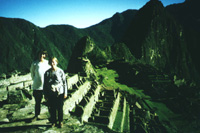
Machu Picchu is an incomparable mountain sanctuary located in southern Peru, but for how long will this wonder of world stay almost untouched? Cable car and giant hotels? Will the Peruvian government really go so far? It is expected that number of tourists will increase to 4000 per day. But what about the fragile nature and preserving of the archaeological heritage? How will this affect if the plans become carried out?
Photo: Machu Picchu - one of the world's wonders - placed on the UNESCO World Heritage list.
How will it looks in the future if the plans for building big luxury hotels become carried out?
Approximately 180,000 people visited annually the Inca Trail and the ruins in the mid 1980s. More recently has number of visitors increased to 300,000, including 7,000 on the Inca trails (Ferreyros, 1988). Accommodation includes a hotel and camping facilities. A museum exists at the ruins and there are plans to develop the area further for tourism (The World Conservation Monitoring Centre).
The Peruvian Government has recently decided to sell the ruins to commercial developers. The infrastructure for tourists will be dramatically extended and probably cause irreversible damages on nature and the unique Inca ruins. Conservation of natural environment?
The ruins of Machu Picchu are the best surviving example of Inca planning and technology, and well known for the beautiful mountains that surrounds it.
But for how long? And how interested will it be in the future to visit Machu Picchu if the "smart" business people carry out their big plans?
Stein Morten Lund, 13 Desember 2000
